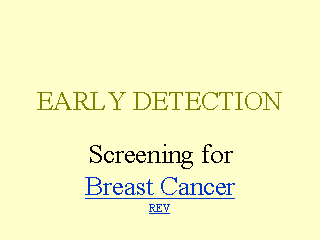Search inside of Supercourse and lectures in HTML and PPT format
 |
|

|
front |1 |2 |3 |4 |5 |6 |7 |8 |9 |10 |11 |12 |13 |14 |15 |16 |17 |18 |19 |20 |21 |22 |23 |24 |25 |26 |27 |28 |29 |30 |31 |review |
 Implementation for screening for breast cancer requires several steps: A program of health education is needed to raise awareness of the disease and the importance of early diagnosis for curability. A policy is needed to restrict examination to women 40 years of age or over (see below). Then a practical and effective mechanism to identify women in the target age group of 40 years of age or over must be devised. Female primary health workers are then trained to examine the breasts and to teach women how to do breast self-examination (BSE).They are also instructed on proper case finding and referral procedures. If resources make mammography available for population screening beyond diagnosis of individual patients, radiologists and radiographers must be trained, stationary and/or mobile mammographic facilities established along with a quality control program for films and readings. A policy is needed to use mammography to screen the group of 50-69 years. A link is needed between identification of an abnormality and referral to be sure that all suspected lesions are properly diagnosed and treated, and that women receive proper follow-up. An information system will also be needed to allow for monitoring and evaluation of the program, including measurement of the downstaging phenomenon. |